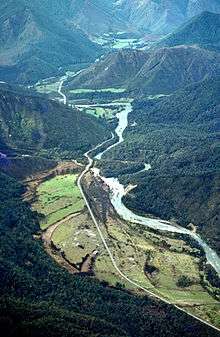Rivers of New Zealand

The rivers of New Zealand are used for a variety of purposes and face a number of environmental issues. Many of the rivers in the South Island are braided rivers.
Statistics
The longest river in New Zealand is the Waikato River with a length of 425 kilometres (264 mi). The largest river by volume is the Clutha River with a mean discharge of 613 cubic metres per second (21,600 cu ft/s).[1]
Some of the rivers, especially those with wide flood plains and stop banks, have long road bridges spanning them. The Rakaia River is crossed by the longest bridge in New Zealand at 1,757 metres (5,764 ft). The third longest bridge is the Whirokino Trestle Bridge on State Highway 1 crossing the Manawatu River.[2]
Over 180,000 kilometres (110,000 mi) of rivers have been mapped in New Zealand.[3]
Uses
Rivers in New Zealand are used for number of purposes. In the early Maori and European history of New Zealand the navigable rivers were used for transportation. There are 1,609 kilometres (1,000 mi) of navigable inland waterways; however these are no longer significant transport routes.
Rivers are used for commercial tourism and recreation activities such as rafting, canoeing, kayaking and jet-boating. Bungy jumping, pioneered as a commercial venture by a New Zealand innovator, is often done above some of the more scenic rivers.
Over half of the electricity generated in New Zealand is hydroelectric power. Hydroelectric power stations have been constructed on many rivers which dam the river completely, or channel a portion of the water through the power station. There is large hydroelectric power scheme in the North Island and in the South Island where water is diverted between rivers using a system of canals that is used to maximise the electricity generation.
Conservation and pollution
River conservation is threatened by pollution inflows from point and non-point sources. In the past rivers had been used for pollution discharges from factories and municipal sewerage plants. With increasing environmental awareness and the passing of the Resource Management Act these sources of pollution are now less problematic. Water abstraction, especially for irrigation, is now a major threat to the character of rivers. An upsurge in conversion of land to dairy farming is stretching water resources. Also, since dairy farming is becoming more intensified in New Zealand and requires large amounts of water, the problem is therefore being exacerbated.
Acid mine drainage (AMD) from the Stockton coal mine has altered the ecology of the Mangatini Stream on the West Coast. The Stockton mine is also leaching AMD into the Waimangaroa River and the proposed Cypress Mine will increase this amount.
There is a high level of pollution in lowland rivers and streams that flow through urban or pastoral farming areas.[4]
A report[5] from the Ministry of Economic Development identified a large number of rivers as being suitable for hydroelectric power production. This report alarmed the Green Party and a number of environmental organisations due to the fear of an increasing loss of scenic rivers and rivers that have a high degree of natural character.
See also
- Water in New Zealand
- Environment of New Zealand
- Water Conservation Order
- Lakes of New Zealand
- Bridges in New Zealand
References
- ↑ Murray, D. L. (1975). "Regional hydrology of the Clutha River" 14 (2). Journal of Hydrology (N.Z.): 85–98.
- ↑ Transit New Zealand FAQs
- ↑ Young, David (2009-03-01). Rivers - How New Zealand rivers are formed. Te Ara - the Encyclopedia of New Zealand (Ministry for Culture and Heritage / Te Manatu- Taonga). ISBN 978-0-478-18451-8. Retrieved 2010-08-07.
- ↑ Scott T. Larned, Mike R. Scarsbrook, Ton H. Snelder, Ned J. Norton, Barry J. F. Biggs (2004). "Water quality in low-elevation streams and rivers of New Zealand: recent state and trends in contrasting land-cover classes". New Zealand Journal of Marine and Freshwater Research (The Royal Society of New Zealand) 38: 347–366. doi:10.1080/00288330.2004.9517243.
- ↑ East Harbour Management Services (January 2004). "Identification of Potential Hydroelectric Resources". http://www.med.govt.nz/templates/MultipageDocumentTOC____12563.aspx. Retrieved 2009-03-21. External link in
|publisher=(help)
Further reading
- Mosley, M Paul, ed. (1992). Waters of New Zealand. Wellington: New Zealand Hydrological Society. ISBN 0-473-01667-2.
- Egarr, Graham; Jan Egarr; John Mackay. 64 New Zealand rivers: a scenic evaluation. Auckland: New Zealand Canoeing Association.
- Collier, K.J.; Clapcott, J.E.; Young, R.G. (August 2009). Influence of Human Pressures on Large River Structure and Function (PDF). CBER Contract Report 95. Centre for Biodiversity and Ecology Research.
External links
- New Zealand Hydrological Society
- National Institute of Water & Atmospheric Research - National Centre for Water Resources
- Wild Rivers - a campaign to protect rivers
- Whitewater NZ (formerly New Zealand Recreational Canoeing Association)
- Ministry for the Environment - water information page
- League table of the suitability of New Zealand rivers for contact recreation from NIWA